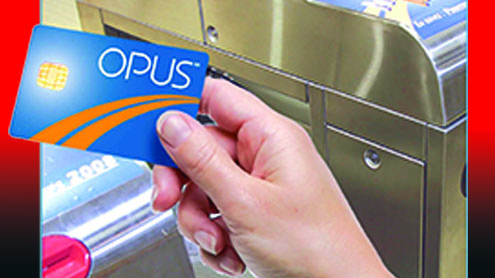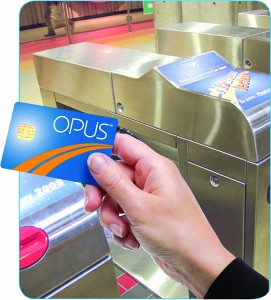
The Société de transport de Montréal (STM), Montreal, QC, Canada, turns to the OPUS smartcard
By Richard Tackett
In 2008 the Société de transport de Montréal (STM), Montreal, QC, Canada turned to the OPUS smartcard where before riders made cash and magnetic stripe payments for bus fares. Guylaine St-Louis, STM manager, Strategy, Development and Partnerships for E-ticketing, says the need for the OPUS card came from several well defined objectives including the need for additional fare flexibility. Today, STM and 17 other agencies are using the same consolidated OPUS system, in which electronic fares make up almost 90 percent of STM’s total sales.
St-Louis says STM has introduced new fares since deploying the system. STM operates over 1,700 buses on 213 lines and 4 electric metro lines (68 stations), over a territory of 500 square kilometers.
“These include evening time fares, weekend fares and different fares to attract transit customers,” she says. “We wouldn’t be able to do that with the old paper tickets.”
Rene Coutu, STM’s E-ticketing studies’ director, says the agency didn’t initially know how customers would react to the new smartcards. The systematic introduction of the new system in Montreal from east to west eliminated any doubt.
“As soon as it was out in the east of Montreal, the people in the west were asking about the OPUS cards,” says Coutu. “Some even traveled east to buy their cards immediately.”
Coutu says that improved collection measures were also key to the system’s introduction.

“We knew that old fare collection system and procedures had gaps that allowed for some fraud to exist.” he says. “In fact, we were in the knowledge of a few bad practices from some of our customers, and the OPUS card was about to put an end to that”.
Ten years in the making
STM, along with participating transit agencies, initiated discussions of the OPUS project from 2000 to 2003, awarding contracts for acquisition of the necessary equipment and the centralized system. The agency designed and tested the system until 2005 when it began installing the equipment. STM introduced new fare formats and began operating the system in 2008. The final stages of deployment occurred in March 2010 and concluded with the final removal of old equipment.
“We changed all of the bus fareboxes prior to the inauguration of the OPUS card,” says Coutu. “We made sure at least one turnstile in every subway station had the capacity to read the card. We moved from one region to another slowly introducing the new card while the old cards were in use.”
ATLAS ® drives the central system
OPUS operates on an offline centralized system from Xerox called ATLAS ®. STM ensured the equipment can operate without any link to the main system for a few days.
“Our system is a card-based system, the opposite of an account-based system,” St-Louis says. “The customer’s fare is on the card’s chip itself. The machine reads the fare directly on the card as the customer ‘taps in’. Back then, at the implementation, this saved us from the cost of putting everything online.”
The ATLAS ® system includes a number of databases with different functions. The SBIL database is the largest and stores information to cards, fares and customers. The server of detailed data (SDD) reports the details of each transaction, while the server of consolidated data (SDC) reports monthly transaction information. The server of all applications (SAPP) processes transaction data every night and spreads it to the other servers.
“The server’s main goal is to allow all of the equipment, all of the fareboxes and systems on the buses, to connect every night,” Coutu says. “The server gives the equipment all of the parameters needed to work the following day, and the equipment communicates the data of the past 24 hours to the servers.”
OPUS loads from home
Up next for STM is the introduction of a new fare collection method: loading your OPUS smartcard from home.
“Parents don’t have to travel to a machine or the store to get their kids fares for school,” St-Louis says. “They can just do it at home with one payment. It’s very easy. We received some really good comments in our experimentation phase.”
Though it is currently only a pilot program, in approximately a year, customers will be able to obtain an at-home card reader that connects to a computer or laptop via USB. By plugging in the reader and inserting a smartcard, users can go online and remotely load fares to their OPUS card.
“For our customers, it’s a 24/7 solution,” St-Louis says.
“The home reader is cost-effective for us, that’s for sure,” Coutu adds. “It’s easier to provide that kind of service compared to maintenance of the subway machines. It’s a fantastic win-win solution. BR
